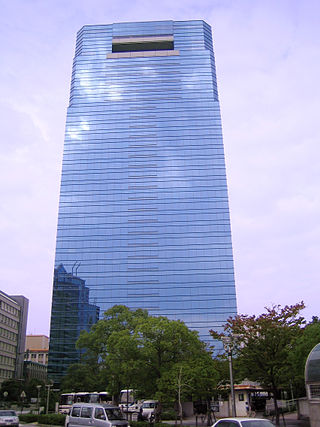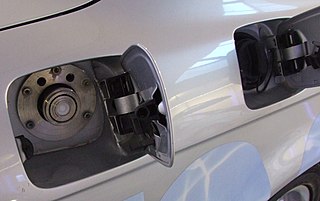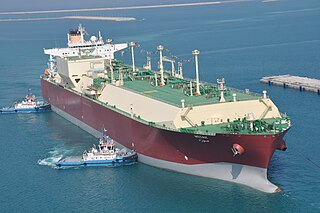
A hydrogen tanker or liquid hydrogen tanker is a tank ship designed for transporting liquefied hydrogen.

A hydrogen tanker or liquid hydrogen tanker is a tank ship designed for transporting liquefied hydrogen.
The World Energy Network research program of the Japanese New Sunshine Project was divided into 3 phases [1] during the period 1993 to 2002, its goal was to study the distribution of liquid hydrogen with hydrogen tankers [2] based on the LNG carrier technology of self-supporting tank designs such as the prismatic and spherical tank. Further research on maritime transport of hydrogen was done in the development for safe utilization and infrastructure of hydrogen project (2003–2007). [3]
Similar to an LNG carrier the boil off gas can be used for propulsion of the ship. [4]
The "Suiso Frontier" collected a cargo of liquid hydrogen from the port of Hastings in Victoria, Australia on 28 January 2022 and arrived back in Kobe, Japan at the end of February, 2022 with the cargo. [5] A second cargo was collected from the Hastings terminal in May, 2022 with a return to Japan in June 2022. [6]
In November 2022, Approval in Principle (AiP) was granted by Nippon Kaiji Kyokai (ClassNK) for Kawasaki Heavy Industries's dual fuel generator engine using hydrogen gas as fuel, which will be installed on a 160,000 m3 liquefied hydrogen carrier developed by Kawasaki. Kawasaki intends to conduct a demonstration test of this engine after installing it on a large-scale liquefied hydrogen carrier which is planned to be commercialized in the mid-2020s. [4] [7] In June 2023, Kawasaki Heavy Industries announced its completion of technological development for a cargo containment system (CCS) to be used in large liquefied hydrogen carriers. [8]

Liquid hydrogen (H2(l)) is the liquid state of the element hydrogen. Hydrogen is found naturally in the molecular H2 form.

Kawasaki Heavy Industries Ltd. (KHI) is a Japanese public multinational corporation manufacturer of motorcycles, engines, heavy equipment, aerospace and defense equipment, rolling stock and ships, headquartered in Chūō, Kobe and Minato, Tokyo, Japan. It is also active in the production of industrial robots, gas turbines, pumps, boilers and other industrial products. The company is named after its founder, Shōzō Kawasaki. KHI is known as one of the three major heavy industrial manufacturers of Japan, alongside Mitsubishi Heavy Industries and IHI. Prior to the Second World War, KHI was part of the Kobe Kawasaki zaibatsu, which included Kawasaki Steel and Kawasaki Kisen. After the conflict, KHI became part of the DKB Group (keiretsu).
Cryogenic fuels are fuels that require storage at extremely low temperatures in order to maintain them in a liquid state. These fuels are used in machinery that operates in space where ordinary fuel cannot be used, due to the very low temperatures often encountered in space, and the absence of an environment that supports combustion. Cryogenic fuels most often constitute liquefied gases such as liquid hydrogen.

Liquefied natural gas (LNG) is natural gas (predominantly methane, CH4, with some mixture of ethane, C2H6) that has been cooled down to liquid form for ease and safety of non-pressurized storage or transport. It takes up about 1/600th the volume of natural gas in the gaseous state at standard conditions for temperature and pressure.

A Natural Gas Vehicle (NGV) is an alternative fuel vehicle that uses compressed natural gas (CNG) or liquefied natural gas (LNG). Natural gas vehicles should not be confused with autogas vehicles powered by liquefied petroleum gas (LPG), mainly propane, a fuel with a fundamentally different composition.

A tanker is a ship designed to transport or store liquids or gases in bulk. Major types of tankship include the oil tanker, the chemical tanker, cargo ships, and a gas carrier. Tankers also carry commodities such as vegetable oils, molasses and wine. In the United States Navy and Military Sealift Command, a tanker used to refuel other ships is called an oiler but many other navies use the terms tanker and replenishment tanker. Tankers were first developed in the late 19th century as iron and steel hulls and pumping systems were developed. As of 2005, there were just over 4,000 tankers and supertankers 10,000 LT DWT or greater operating worldwide.
LNG El Paso Sonatrach was a liquefied natural gas carrier (LNG) of the El Paso Marine Corporation which was active in the late 1970s. Although she was US owned, the ship was registered in Liberia because of tax and economical reasons.

A bivalent engine is an engine that can use two different types of fuel. Examples are petroleum/CNG and petroleum/LPG engines, which are widely available in the European passenger vehicle aftermarket.

Marine propulsion is the mechanism or system used to generate thrust to move a watercraft through water. While paddles and sails are still used on some smaller boats, most modern ships are propelled by mechanical systems consisting of an electric motor or internal combustion engine driving a propeller, or less frequently, in pump-jets, an impeller. Marine engineering is the discipline concerned with the engineering design process of marine propulsion systems.

An LNG carrier is a tank ship designed for transporting liquefied natural gas (LNG).

The YF-77 is China's first cryogenic rocket engine developed for booster applications. It burns liquid hydrogen fuel and liquid oxygen oxidizer using a gas generator cycle. A pair of these engines powers the LM-5 core stage. Each engine can independently gimbal in two planes. Although the YF-77 is ignited prior to liftoff, the LM-5's four strap-on boosters provide most of the initial thrust in an arrangement similar to the European Vulcain on the Ariane 5 or the Japanese LE-7 on the H-II.
A hydrogen ship is a hydrogen fueled ship, using an electric motor that gets its electricity from a fuel cell, or hydrogen fuel in an internal combustion engine.

Q-Max is a type of ship, specifically a membrane type LNG carrier. In the name Q-Max, "Q" stands for Qatar and "Max" for the maximum size of ship able to dock at the Liquefied natural gas (LNG) terminals in Qatar. Ships of this type are the largest LNG carriers in the world.
Compressed natural gas (CNG) carrier ships are those designed for transportation of natural gas under high pressure. CNG carrier technology relies on high pressure, typically over 250 bar (2900 psi), to increase the density of the gas, but it is still 2.4 times less than that of LNG (426 kg/m3). CNG carriers may find their place abreast with the well established technology of liquefied natural gas by LNG carriers as it is economical for medium distance marine transport. Most of the energy consumed for the gas pressurisation can be recovered as electricity using turboexpander while delivering CNG to the inland piping network at unloading jetty/harbour. CNG carriers are also alternate solutions to the undersea pipelines as they have less complicated fast loading and unloading features.

A gas carrier, gas tanker, LPG carrier, or LPG tanker is a ship designed to transport LPG, LNG, CNG, or liquefied chemical gases in bulk.

A liquefied natural gas terminal is a facility for managing the import and/or export of liquefied natural gas (LNG). It comprises equipment for loading and unloading of LNG cargo to/from ocean-going tankers, for transfer across the site, liquefaction, re-gasification, processing, storage, pumping, compression, and metering of LNG. LNG as a liquid is the most efficient way to transport natural gas over long distances, usually by sea.

A marine LNG engine is a dual fuel engine that uses natural gas and bunker fuel to convert chemical energy in to mechanical energy. Due to natural gas' cleaner burning properties, the use of natural gas in merchant ship propulsion plants is becoming an option for companies in order to comply with IMO and MARPOL environmental regulations. The natural gas is stored in liquid state (LNG) and the boil-off gas is routed to and burned in dual fuel engines. Shipping companies have been cautious when choosing a propulsion system for their fleets. The steam turbine system has been the main choice as the prime mover on LNG carriers over the last several decades. The decades-old system on steam propelled LNG carriers uses BOG. LNG carriers are heavily insulated to keep the LNG at around -160 °C – to keep it liquefied. Despite insulation, the LNG containment area is penetrated by heat which allows for naturally generated boil-off gas (BOG).
MV Damia Desgagnés is an asphalt-bitumen-chemical tanker owned and operated by Groupe Desgagnés for service on the Saint Lawrence Seaway. The ship was completed in March 2017. Damia Desgagnés is the first Canadian-flagged tanker to have a duel-fuel-powered propulsion system. The first of four ships of such a design, Damia Desgagnés ran aground on its first trip through the Saint Lawrence Seaway.
Gaztransport & Technigaz SA is a French multinational naval engineering company with headquarters in Saint-Rémy-lès-Chevreuse, France.

The Suiso Frontier is the world's first liquid hydrogen carrier ship. Built by the Kawasaki Heavy Industries, it was put into service in 2019.